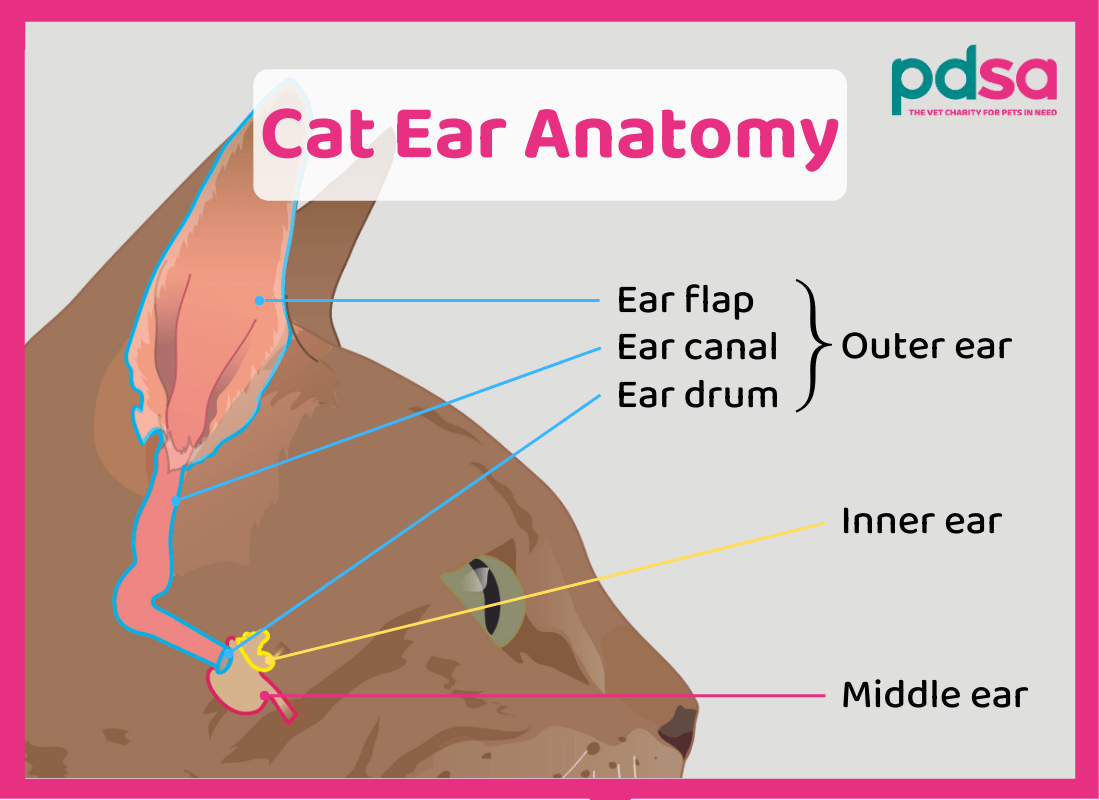Ear infections in cats
Overview
- Ear infections in cats usually develop if there is an underlying problem with the ear(s), for example, ear mites, skin allergies or perhaps a polyp inside the ear canal - they rarely develop without an underlying cause.
- Ear infections are painful, itchy and smelly and, left untreated, can cause permanent damage to the ear.
- It’s important to have your cat seen by a vet quickly if you notice signs of an ear infection.
- Treatment is likely to include pain relief, ear drops and, if necessary, medication or surgery for the underlying cause.
Causes of ear infections in cats
Ear infections in cats are caused by an overgrowth of bacteria or yeast inside the ear canal, and they usually develop if there is an underlying problem inside the ear, such as:
Ear mites – a common cause of ear infections in cats and kittens. They cause an intense itch and lots of crusty discharge.
Fleas – fleas can cause itchy, inflamed skin and an ear infection. This is especially common in cats with severe infestations or flea allergic dermatitis (allergy to fleas).
Allergic skin disease – allergic skin disease can make the skin inside the ear very sensitive and prone to infection.
An ear injury – an injury inside the ear can lead to infection if it isn’t kept clean.
Something stuck in the ear – occasionally objects such as grass seeds get stuck in the ear and cause infection.
Growths inside the ear – growths inside the ear such as polyps and tumours can cause infections - these are less common than most other causes.
Symptoms of ear infections in cats
There are three main parts to a cat’s ear - the outer ear, the middle ear, and the inner ear (see diagram above). Infections of the outer ear are by far the most common and cause the following symptoms:
- An itchy ear
- Heat and swelling around the ear
- Pain around the ear – your cat may become head shy/avoid being stroked
- A smelly ear
- Head shaking and face rubbing
- A swollen, droopy earflap (also called an ‘aural haematoma’)
- Discharge, dirt, excess wax or blood from the affected ear(s)
If your cat has a middle or inner ear infection, they might also develop the following symptoms:
- A head tilt
- Loss of balance
- Flickering eye movements

Treatment
Ear infections usually require the following treatment:
Ear drops – to combat infection and reduce swelling (most ear drops contain antibiotics, anti-fungus and anti-inflammatory ingredients). Only ever use ear drops prescribed by your vet and make sure to finish the course, even if your cat seems better before it’s finished – stopping early could result in a more serious infection returning.
Ear cleaner – to help clear the infection by removing any excess wax, pus and discharge. Check out our video below ‘How to clean your cat’s ears’.
Anti-inflammatory pain relief– if your cat’s ear is very painful they might need anti-inflammatory pain relief in addition to their ear drops. This is usually given by mouth or injection.
Antibiotics – most of the time, antibiotic ear drops are enough to combat an ear infection but if your cat has a very serious or deep ear infection they may need antibiotic tablets or an injection.
Treating the underlying cause – if there is an underlying cause behind your cat’s ear infection (which is often the case), they will need this treated. For example, if they have ear mites, they will need some anti-parasitic treatment. If your vet suspects your cat might have allergic skin disease they will need some treatment to manage it, or if they have something stuck in their ear they will need it removed.
Treatment for an aural haematoma – if your cat has developed an ‘aural haematoma’ as part of their ear infection, which is essentially a blood blister inside the ear flap, they might need to have it drained or operated on. For more information, check out our page Aural Haematomas in Cats.
What if it doesn’t get better?
As long as you follow the instructions given to you by your vet, and return for check-up appointments as necessary, it’s likely your cat’s ear infection will improve. However, if they are still having problems after a course of treatment, your vet may need to do some further investigations to find out why, such as an ear examination and/or swab under anaesthetic.
Cost
Treating an ear infection can become expensive so it’s important to speak openly to your vet about what you can afford, as well as what you think is right for your cat. There are often several treatment options so if one doesn’t work for you and your pet then the vet may be able to offer another.
One of the best ways to protect yourself from unexpected vet bills is by insuring your cat as soon as you get them, before any signs of illness start
Published: January 2023
Did you find this page useful?
Tell us more
Please note, our vets and nurses are unable to respond to questions via this form. If you are concerned about your pet’s health, please contact your vet directly.
Thank you for your feedback
Want to hear more about PDSA and get pet care tips from our vet experts?
Sign up to our e-newsletter
Written by vets and vet nurses. This advice is for UK pets only. Illustrations by Samantha Elmhurst.

 Video found at youtu.be/OGjhzON4jaE
Video found at youtu.be/OGjhzON4jaE
